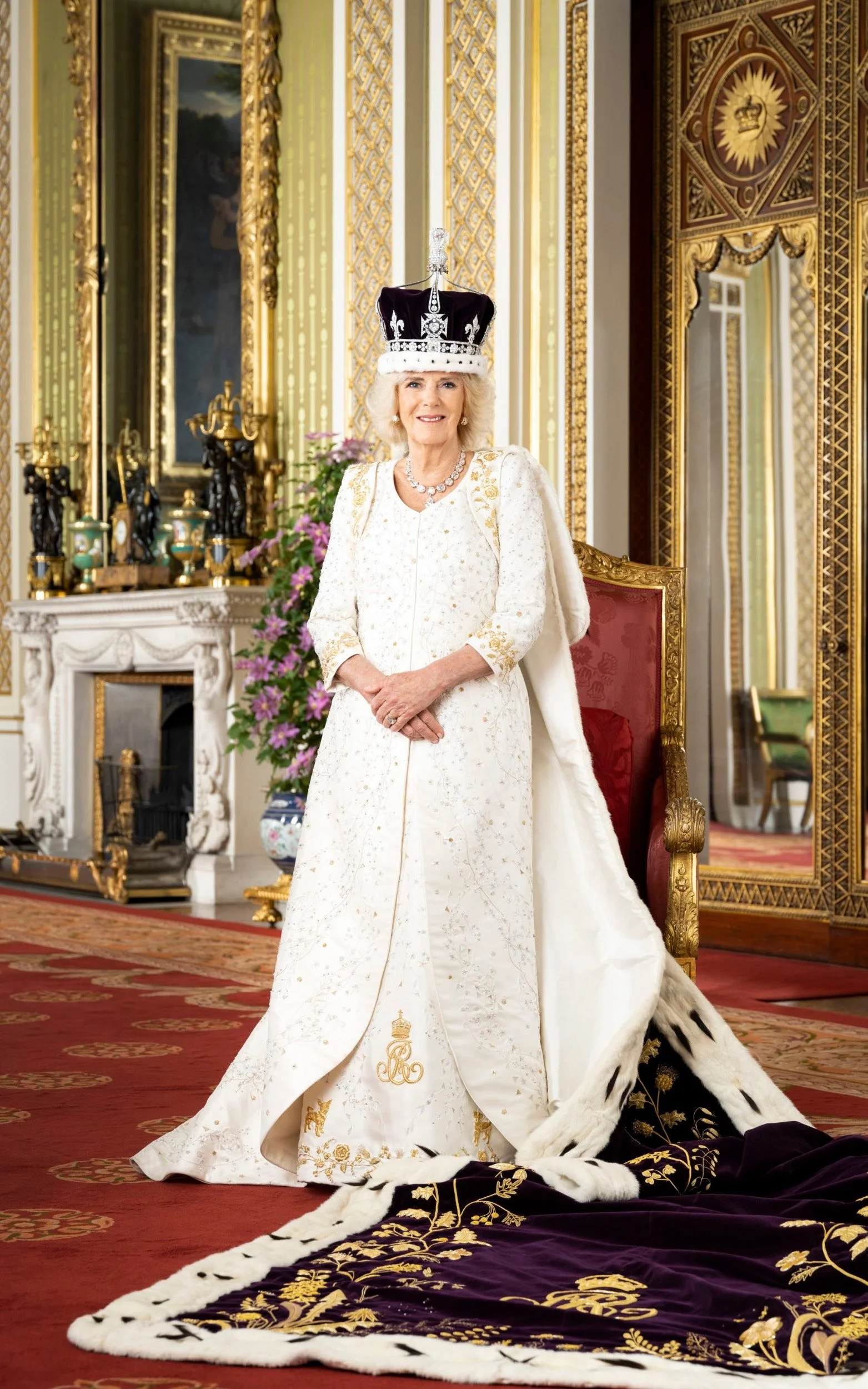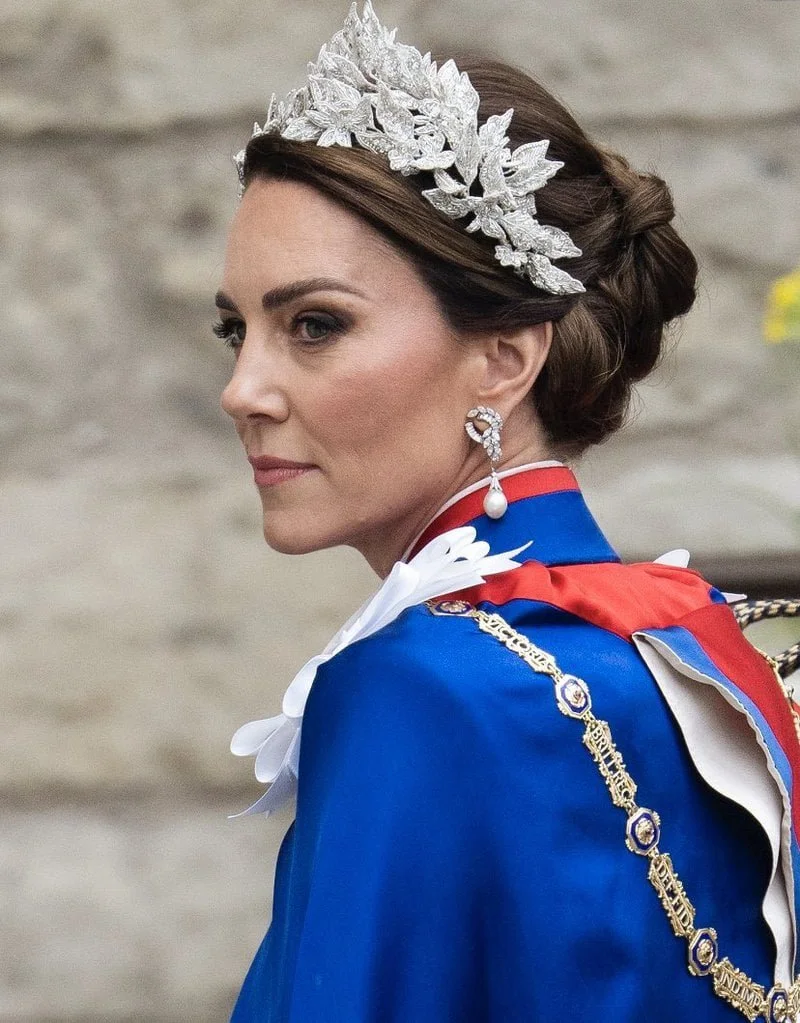Focus on King Charles' Coronation exquisite gold embroidery, with Maria Francesca Broggini.
WRITTEN BY FRANCESCA POLIZZI & MARIA FRANCESCA BROGGINI
It's May 06th 2023; it's a rainy day in London, yet this doesn't stop the trumpets, shots fired, bells and notes of God Save the King echoing through the city. This is an historic and memorable day, not only for the Royal family, the United Kingdom and the members of the Commonwealth, but for all of us who wouldn’t miss a single detail of such a ritualistic, symbolic and ceremonial event, all hidden behind the vast public spectacle! Moreover, for those of us who observe from afar, it is the first time in history that we are allowed to observe everything.. really everything, down to the smallest of details, the subtlest of gestures.
Today's story has a special twist, as it was written by four hands!
You may already know Maria Francesca Broggini: creative, craftswoman and founder of Aembrosia.
Maria Francesca is one of the few (and one of the youngest!) Italian craftswomen to practice the precious technique of gold thread embroidery.
This kind of embroidery is not made using traditional gold-coloured 'needlework'; in fact, the most precious technique consists in the application of metallic threads, dipped in pure 24kt gold.
“I had the good fortune to learn this age-old technique directly from the Royal School of Needlework: embroidery school and atelier sponsored by the Royal household, which crafted most of the precious embroidery for the coronation.”
Who better than Maria Francesca to help us understand the symbolisms and techniques behind the objects and clothing used during this memorable day in the Westminster Abbey?
FIND OUT MORE ABOUT MARIA FRANCESCA IN THIS PAST ARTICLE DEDICATED TO HER
“During the coronation of H.M. King Charles III we were able to admire a riot of gold embroidery, the highest expression of traditional ornaments linked to the royal household, the ecclesiastical sphere and the military. All the sacredness, solemnity and royalty of this technique was a common thread throughout the whole ceremony. Most of the items embroidered in gold were ancient, made by and for ancestors of King Charles and reused after appropriate restoration, following the Charles’ interests of sustainability.”
“We were able to admire in particular the various cloaks of the King and His family members, (embroidered with heraldic/floral motifs), the chairs with embroidered initials (Chairs of Estate and Throne Chairs), coats of arms on the back and even the dress of the queen consort Camilla and the cloth of the Archbishop of Canterbury featured large sections of gold embroidery.”
“The soldiers, knights and other official figures of the ceremony wore a riot of precious embroidery, as did Penelope Mordaunt, Lord President of the Council. She played one of the key roles at King Charles' coronation, carrying the State Sword in a beautiful petrol-blue dress, complete with matching headband and cape, featuring an exquisite gold embroidered ramage.
Yet, above all, every garment and textile accessory featured at the coronation was embroidered in gold: it is indeed an unfailing technique on this occasion and was worn by the King on his cloaks, on his golden Supertunic (inspired by the robes of Byzantine emperors) and matching stole, even down to the glove of the hand that held the sceptre.
Gold, in this case, truly has an alchemical significance, representing the divine light that strikes the sovereign, investing him with his power to rule justly. Furthermore, the English King is also head of the Anglican church, which adds a further level of depth to the use of gold embroidery for this ceremony: putting it at the same level of those used on the sacred vestments of the Catholic Church.”
A closer look to the Queen Consort’s Robe of Estate
“The dark purple velvet edged with ermine is traditionally embellished with beautiful gold embroidered motifs.
A more feminine and floral motif was chosen for the mantle of the Queen Consort Camilla. Within the design are the queen's figures, and several species of flowers and for the first time even insects, underlining Charles' love for the environment and nature.
We find a total of 24 botanical species, all with an allegorical meaning or linked to personal memories: the lily of the valleys, for example, was one of Queen Elisabeth's favourite flowers, also present in Camilla's wedding bouquet; the myrtle represents hope, and the oak strength and longevity. There is no shortage of plants associated with England (tudor rose), Ireland (clover), Scotland (thistle) and Wales (yellow narcissus), recurring motifs in royal embroideries.
In the centre bottom the two abandoned dogs she has adopted are visible, along with the names of her children and grandchildren.
From a technical point of view..
..many different techniques have been used to create these designs, which make the best use of the wide expressive range of gold embroidery; in fact, contrary to what one might think, gold embroidery is not just a type of stitch or material used in embroidery, yet it is an entire category of workmanship, encompassing dozens, if not hundreds, of possibilities in all possible variations.
It is a veritable arsenal of expression and it is amazing how many different effects and textures can be achieved with just one colour!
In Camilla's Robe of Estate, for instance, there are both areas worked with metallic yarns (i.e. cotton threads covered with a metal foil) and canutiles (i.e. long, spiral tubes of metal, hollow on the inside). These two major families of gold embroidery materials involve very different techniques to be laid, yet have in common the prerogative of applying the precious material only to the front of the fabric.
Credits Images above: Royal School of Needlework
“In general, gold embroidery in the English style makes extensive use of canutiles, which are placed on a felt padding or other similar materials. The sculptural appearance and development of the design enhance the precious metals, which are bathed in 24kt gold.
Each and every motif and design have been perfected and passed down over the centuries to work best with the traditional technique.
“The greatest challenge of gold embroidery (and all the most precious craft techniques) is innovation, which may mean totally changing the subject materials or also the crafting tools, the way of working the material itself; every change brings with it the possibility of failure and therefore having to make many attempts to achieve a good result.
For instance, I have experimented with three-dimensional shapes worked with canutille and other techniques of haute couture embroidery, making embroidered leaves, flowers and animals mounted on hair accessories.
Imagine my surprise when Kate Middleton and daughter Charlotte's tiaras were made in a very similar way!”
I was enthusiastic to see that the general trend in this sector is innovation, even within the frame of such important and traditional ceremonies and that embroidery can become an interpreter of social changes.”
Follow & support Maria Francesca on Instagram!
Credits: photos from WPA / Getty Images | Royal School of Needlework













